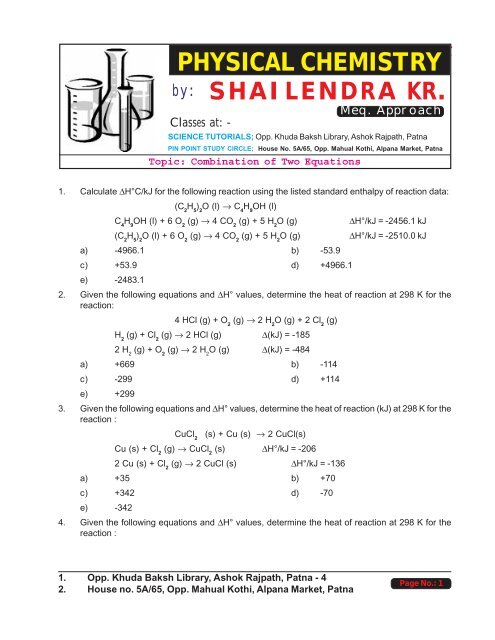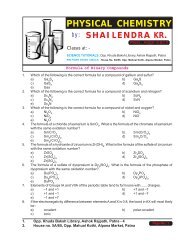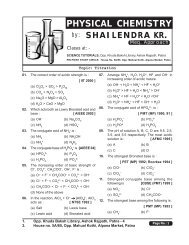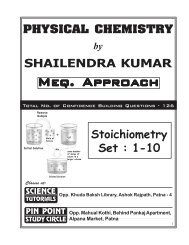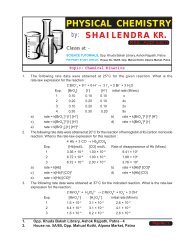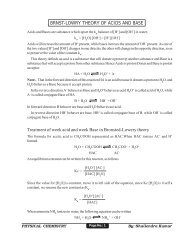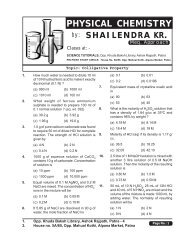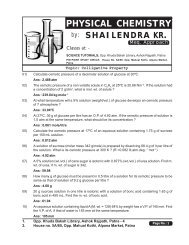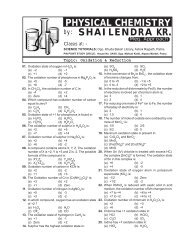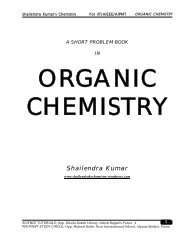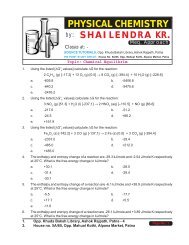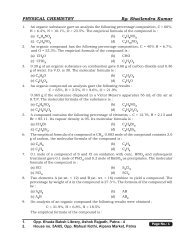Combination of two Equation - Shailendra Kumar Chemistry
Combination of two Equation - Shailendra Kumar Chemistry
Combination of two Equation - Shailendra Kumar Chemistry
Create successful ePaper yourself
Turn your PDF publications into a flip-book with our unique Google optimized e-Paper software.
PHYSICAL CHEMISTRY<br />
By: <strong>Shailendra</strong> <strong>Kumar</strong><br />
PHYSICAL CHEMISTRY<br />
by: SHAILENDRA KR.<br />
Classes at: -<br />
Meq. Approach<br />
SCIENCE TUTORIALS; Opp. Khuda Baksh Library, Ashok Rajpath, Patna<br />
PIN POINT STUDY CIRCLE; House No. 5A/65, Opp. Mahual Kothi, Alpana Market, Patna<br />
Topic: <strong>Combination</strong> <strong>of</strong> Two <strong>Equation</strong>s<br />
1. Calculate ∆H°C/kJ for the following reaction using the listed standard enthalpy <strong>of</strong> reaction data:<br />
(C 2<br />
H 5<br />
) 2<br />
O (l) → C 4<br />
H 9<br />
OH (l)<br />
C 4<br />
H 9<br />
OH (l) + 6 O 2<br />
(g) → 4 CO 2<br />
(g) + 5 H 2<br />
O (g)<br />
∆H°/kJ = -2456.1 kJ<br />
(C 2<br />
H 5<br />
) 2<br />
O (l) + 6 O 2<br />
(g) → 4 CO 2<br />
(g) + 5 H 2<br />
O (g) ∆H°/kJ = -2510.0 kJ<br />
a) -4966.1 b) -53.9<br />
c) +53.9 d) +4966.1<br />
e) -2483.1<br />
2. Given the following equations and ∆H° values, determine the heat <strong>of</strong> reaction at 298 K for the<br />
reaction:<br />
4 HCl (g) + O 2<br />
(g) → 2 H 2<br />
O (g) + 2 Cl 2<br />
(g)<br />
H 2<br />
(g) + Cl 2<br />
(g) → 2 HCl (g) ∆(kJ) = -185<br />
2 H 2<br />
(g) + O 2<br />
(g) → 2 H 2<br />
O (g) ∆(kJ) = -484<br />
a) +669 b) -114<br />
c) -299 d) +114<br />
e) +299<br />
3. Given the following equations and ∆H° values, determine the heat <strong>of</strong> reaction (kJ) at 298 K for the<br />
reaction :<br />
CuCl 2<br />
2 (s) + Cu (s) → 2 CuCl(s)<br />
Cu (s) + Cl 2<br />
(g) → CuCl 2<br />
(s) ∆H°/kJ = -206<br />
2 Cu (s) + Cl 2<br />
(g) → 2 CuCl (s) ∆H°/kJ = -136<br />
a) +35 b) +70<br />
c) +342 d) -70<br />
e) -342<br />
4. Given the following equations and ∆H° values, determine the heat <strong>of</strong> reaction at 298 K for the<br />
reaction :<br />
1. Opp. Khuda Baksh Library, Ashok Rajpath, Patna - 4<br />
2. House no. 5A/65, Opp. Mahual Kothi, Alpana Market, Patna<br />
Page No.: 1
PHYSICAL CHEMISTRY<br />
1. Opp. Khuda Baksh Library, Ashok Rajpath, Patna - 4<br />
2. House no. 5A/65, Opp. Mahual Kothi, Alpana Market, Patna<br />
By: <strong>Shailendra</strong> <strong>Kumar</strong><br />
C 2<br />
H 4<br />
(g) + 6 F 2<br />
(g) → 2 CF 4<br />
(g) + 4 HF (g)<br />
H 2<br />
(g) + F 2<br />
(g) → 2 HF (g) ∆H°/kJ = -537<br />
C (s) + 2 F 2<br />
(g) → CF 4<br />
(g) ∆H°/kJ = -680<br />
2 C (s) + 2 H 2<br />
(g) → C 2<br />
H 4<br />
(g) ∆H°/kJ = +52.3<br />
a) +2486 b) -2486<br />
c) -2132 d) +1165<br />
e) -1165<br />
5. Given the following equations and ∆H° values, determine the heat <strong>of</strong> reaction at 298 K for the<br />
reaction :<br />
C (s) + 2 H 2<br />
(g) → CH 4<br />
(g)<br />
C (s) + O 2<br />
(g) → CO 2<br />
(g) ∆H°/kJ = -393.5<br />
H 2<br />
(g) + 1/2 O 2<br />
(g) → H 2<br />
O (l) ∆H°/kJ = -285.8<br />
CO 2<br />
(g) + 2 H 2<br />
O (l) → CH 4<br />
(g) + 2 O 2<br />
(g) ∆H°/kJ = +890.3<br />
a) -192.2 b) -74.8<br />
c) +74.8 d) +211.0<br />
e) -211.0<br />
6. Given the following equations and ∆H° values, determine the heat <strong>of</strong> reaction at 298 K for the<br />
reaction which occurs in a welder’s acetylene torch:<br />
2 C 2<br />
H 2<br />
(g) + 5 O 2<br />
(g) → 4 CO 2<br />
(g) + 2 H 2<br />
O (l)<br />
H 2<br />
(g) + 1/2 O 2<br />
(g) → H 2<br />
O (l) ∆H°/kJ = -285.8<br />
2 C (s) + H 2<br />
(g) → C 2<br />
H 2<br />
(g) ∆H°/kJ = +226.7<br />
C (s) + O 2<br />
(g) → CO 2<br />
(g) ∆H°/kJ = -393.5<br />
a) -571.6 b) -2599.0<br />
c) -1574.0 d) -2145.6<br />
e) -285.8<br />
7. Given the following equations and ∆H° values, determine the heat <strong>of</strong> reaction (kJ) at 298 K for the<br />
reaction:<br />
2 NF 3<br />
(g) + Cu (s) → N 2<br />
F 4<br />
(g) + CuF 2<br />
(s)<br />
2 NF 3<br />
(g) + 2 NO (g) → N 2<br />
F 4<br />
(g) + 2 NOF (g) ∆H°/kJ = -82.9<br />
NO (g) + 1/2 F 2<br />
(g) → NOF (g) ∆H°/kJ = -156.9<br />
Cu (s) + F 2<br />
(g) → CuF 2<br />
(g) ∆H°/kJ = -531.0<br />
a) +770.8 b) +291.2<br />
c) -291.6 d) -300.1<br />
e) -605.0<br />
8. Calculate the standard enthalpy change (kJ) for the following reaction <strong>of</strong> nitrogen dioxide with<br />
water:<br />
Page No.: 2
PHYSICAL CHEMISTRY<br />
1. Opp. Khuda Baksh Library, Ashok Rajpath, Patna - 4<br />
2. House no. 5A/65, Opp. Mahual Kothi, Alpana Market, Patna<br />
By: <strong>Shailendra</strong> <strong>Kumar</strong><br />
3 NO 2<br />
(g) + H 2<br />
O (l) → 2 HNO 3<br />
(aq) + NO (g)<br />
2 NO (g) + O 2<br />
(g) → 2 NO 2<br />
(g) ∆H°/kJ = -114 kJ<br />
2 N 2<br />
(g) + 5 O 2<br />
(g) + 2 H 2<br />
O (l) → 4 HNO 3<br />
(aq) ∆H°/kJ = -255 kJ<br />
N 2<br />
(g) + O 2<br />
(g) → 2 NO (g)<br />
∆H°/kJ = +181 kJ<br />
a) -185 b) -268<br />
c) -313 d) -136<br />
e) -224<br />
9. Given the following equations and ∆H° values, determine the heat <strong>of</strong> reaction (kJ) at 298 K for the<br />
reaction:<br />
3 NO 2<br />
(g) + H 2<br />
O (l) → 2 HNO 3<br />
(l) + NO (g)<br />
NH 3<br />
(g) + HNO 3<br />
(l) → NH 3<br />
NO 3<br />
(s) ∆H°/kJ = -145.7<br />
NH 4<br />
NO 3<br />
(s) → N 2<br />
O (g) + 2 H 2<br />
O (l) ∆H°/kJ = -125.2<br />
3 NO (g) → N 2<br />
O (g) + NO 2<br />
(g) ∆H°/kJ = -155.8<br />
4 NH 3<br />
(g) + 5 O 2<br />
(g) → 4 NO (g) + 6 H 2<br />
O (l) ∆H°/kJ = -1169.2<br />
NO (g) + 1/2 O 2<br />
(g) → NO 2<br />
(g) ∆H°/kJ = -56.6<br />
a) -300.1 b) -805.9<br />
c) -685.9 d) -70.4<br />
e) -1291.6<br />
10. Which <strong>of</strong> the following equations represents a reaction that provides the heat <strong>of</strong> formation <strong>of</strong><br />
hydrogen cyanide (HCN)?<br />
a) NH 3<br />
(g) + C (s) → HCN (g) + H 2<br />
(g)<br />
b) CH 4<br />
(g) + N 2<br />
(g) → HCN (g) + NH 3<br />
(g)<br />
c) 1/2 H 2<br />
(g) + C (s) + 1/2 N 2<br />
(g) → HCN (g)<br />
d) CH 3<br />
NH 2<br />
(g) → HCN (g) + 2 H 2<br />
(g)<br />
e) H (g) + C (s) + N (g) → HCN (g)<br />
11. Which <strong>of</strong> the following equations represents a reaction that provides the heat <strong>of</strong> formation <strong>of</strong><br />
Fe 3<br />
O 4<br />
?<br />
a) 3 FeO (s) + H 2<br />
O (g) → Fe 3<br />
O 4<br />
(s) + H 2<br />
(g)<br />
b) 3 Fe (s) + 4 O (g) → Fe 3<br />
O 4<br />
(s)<br />
c) 3 Fe (s) + 2 O 2<br />
(g) → Fe 3<br />
O 4<br />
(s)<br />
d) FeO (s) + Fe 2<br />
O 3<br />
(s) → Fe 3<br />
O 4<br />
(s)<br />
e) 3/2 Fe 2<br />
O 3<br />
(s) → Fe 3<br />
O 4<br />
(s) + 1/2 O 2<br />
(g)<br />
12. Which <strong>of</strong> the following equations represents a reaction that provides the heat <strong>of</strong> formation <strong>of</strong><br />
ethanol (CH 3<br />
CH 2<br />
OH)?<br />
a) CH 2<br />
= CH 2<br />
(g) + H 2<br />
O (l) → CH 3<br />
CH 2<br />
OH (l)<br />
b) 2 CO 2<br />
(g) + 6 H 2<br />
(g) → CH 3<br />
CH 2<br />
OH (l) + 3 H 2<br />
O (l)<br />
Page No.: 3
PHYSICAL CHEMISTRY<br />
By: <strong>Shailendra</strong> <strong>Kumar</strong><br />
c) 2 C (s) + 3 H 2<br />
(g) + 1/2O 2<br />
(g) → CH 3<br />
CH 2<br />
OH (l)<br />
d) 2 CO (g) + 3 H 2<br />
(g) → CH 3<br />
CH 2<br />
OH (l) + 1/2O 2<br />
(g)<br />
e) 2 C (s) + 6 H (g) + O (g) → CH 3<br />
CH 2<br />
OH (l)<br />
13. Calculate ∆H° f<br />
(kJ) for the following reaction from the listed standard enthalpies <strong>of</strong> formation:<br />
PH 3<br />
(g) + 2 O 2<br />
(g) → H 3<br />
PO 4<br />
(s)<br />
∆H° f<br />
PH 3<br />
(g) = +5.4 kJ<br />
∆H° f<br />
H 3<br />
PO 4<br />
(s) = -1279.0 kJ<br />
a) +1284.4 b) -636.8<br />
c) -1284.4 d) -1273.6<br />
e) +1273.6<br />
14. Use the given standard enthalpies <strong>of</strong> formation to determine the heat <strong>of</strong> reaction <strong>of</strong> the heat <strong>of</strong><br />
reaction <strong>of</strong> the following reaction:<br />
N 2<br />
H 4<br />
(l) + O 2<br />
(g) → N 2<br />
(g) + 2 H 2<br />
O (l)<br />
∆H° f<br />
N 2<br />
H 4<br />
(l) = +50.6 kJ/mole<br />
∆H° f<br />
H 2<br />
O (l) = -285.9 kJ/mole<br />
a) -133.5 b) -198.6<br />
c) -622.4 d) -470.6<br />
e) -890.4<br />
15. Calculate ∆H° f<br />
(kJ) for the following reaction from the standard enthalpies <strong>of</strong> formation ∆H° f<br />
NaCl<br />
(s) = -411.15 kJ.<br />
2 Na (s) + Cl 2<br />
(g) → 2 NaCl (s)<br />
a) +411.15 b) 0.0<br />
c) -822.30 d) +822.30<br />
e) -411.15<br />
16. The standard enthalpy <strong>of</strong> formation <strong>of</strong> propane, C 3<br />
H 8<br />
, is -103.6 kJ/mole. Calculate the heat <strong>of</strong><br />
combustion <strong>of</strong> one mole <strong>of</strong> C 3<br />
H 8<br />
. The heats <strong>of</strong> formation <strong>of</strong> CO 2<br />
(g) and H 2<br />
O (l) are -394 kJ/mole<br />
and -285.8 kJ/mole respectively.<br />
a) 2060.0 b) 1721.2<br />
c) -1939.1 d) 2220<br />
e) 1856<br />
17. The standard enthalpy <strong>of</strong> formation <strong>of</strong> methanol, CH 3<br />
OH, is -238.6 kJ/mole. Calculate the heat <strong>of</strong><br />
combustion <strong>of</strong> one mole <strong>of</strong> CH 3<br />
OH. The heats <strong>of</strong> formation <strong>of</strong> CO 2<br />
(g) and H 2<br />
O (l) are -394 kJ/<br />
mole and -285.8 kJ/mole respectively.<br />
a) 976 b) 854<br />
c) 1142 d) 727<br />
e) 1300<br />
1. Opp. Khuda Baksh Library, Ashok Rajpath, Patna - 4<br />
2. House no. 5A/65, Opp. Mahual Kothi, Alpana Market, Patna<br />
Page No.: 4
PHYSICAL CHEMISTRY<br />
1. Opp. Khuda Baksh Library, Ashok Rajpath, Patna - 4<br />
2. House no. 5A/65, Opp. Mahual Kothi, Alpana Market, Patna<br />
By: <strong>Shailendra</strong> <strong>Kumar</strong><br />
18. The standard enthalpy <strong>of</strong> formation <strong>of</strong> benzene, C 6<br />
H 6<br />
, is +49.2 kJ/mole. Calculate the heat <strong>of</strong><br />
combustion <strong>of</strong> one mole <strong>of</strong> C 6<br />
H 6<br />
. The heats <strong>of</strong> formation <strong>of</strong> CO 2<br />
(g) and H 2<br />
O (l) are -394 kJ/mole<br />
and -285.8 kJ/mole respectively.<br />
a) 3420 b) 2150<br />
c) 2860 d) 3270<br />
e) 3560<br />
19. Using the following information calculate the heat <strong>of</strong> formation <strong>of</strong> NF 3<br />
.<br />
NH 3<br />
(g) + 3 F 2<br />
(g) → NF 3<br />
(g) + 2 HF(g)<br />
∆H° = -604.8 kJ<br />
∆H° f<br />
NH 3<br />
(g) = -46.19 kJ/mole<br />
∆H° f<br />
HF(g) = -269 kJ/mole<br />
a) -140 b) -97.2<br />
c) -113 d) -165<br />
e) -198<br />
20. The heat <strong>of</strong> formation <strong>of</strong> PCl 3<br />
(g) is -287.0 kJ/mole. What is the heat <strong>of</strong> reaction for the following<br />
process?<br />
2 PCl 3<br />
(g) → 2 P(s) + 3 Cl 2<br />
(g)<br />
a) +306.4 b) -612.8<br />
c) +153.2 d) -306.4<br />
21. Using the following information calculate the heat <strong>of</strong> formation <strong>of</strong> HCl.<br />
2 Cl 2<br />
(g) + 2 H 2<br />
O (l) → 4 HCl (g) + O 2<br />
(g)<br />
∆H° = +202.5 kJ ∆H° f<br />
H 2<br />
O (l) = -285.85 kJmole<br />
a) +122.5 b) -193.5<br />
c) -92.3 d) +92.3<br />
e) -122.5<br />
22. The heats <strong>of</strong> formation <strong>of</strong> CO 2<br />
(g) and H 2<br />
O (l) are -394 kJ/mole and -285.8 kJ/mole respectively.<br />
Using the data for the following combustion reaction, calculate the heat <strong>of</strong> formation <strong>of</strong> C 6<br />
H 6<br />
(l).<br />
2 C 6<br />
H 6<br />
(l) + 15 O 2<br />
(g) → 12 CO 2<br />
(g) + 6 H 2<br />
O (l)<br />
∆H° = -6541.1 kJ<br />
a) -49.2 b) 49.2<br />
c) 20.2 d) 61.2<br />
e) -61.2<br />
23. The heats <strong>of</strong> formation <strong>of</strong> CO 2<br />
(g) and H 2<br />
O (l) are -394 kJ/mole and -285.8 kJ/mole respectively.<br />
Using the data for the following combustion reaction, calculate the heat <strong>of</strong> formation <strong>of</strong> C 3<br />
H 4<br />
(g).<br />
C 3<br />
H 4<br />
(g) + 4 O 2<br />
(g) → 3 CO 2<br />
(g) + 2 H 2<br />
O (l)<br />
∆H° = -1939.1 kJ<br />
Page No.: 5
PHYSICAL CHEMISTRY<br />
By: <strong>Shailendra</strong> <strong>Kumar</strong><br />
a) 212.2 b) 185.4<br />
c) -103.8 d) 20.4<br />
e) -143.3<br />
24. The heats <strong>of</strong> formation <strong>of</strong> CO 2<br />
(g) and H 2<br />
O (l) are -394 kJ/mole and -285.8 kJ/mole respectively.<br />
Using the data for the following combustion reaction, calculate the heat <strong>of</strong> formation <strong>of</strong> C 2<br />
H 2<br />
(g).<br />
2 C 2<br />
H 2<br />
(l) + 5 O 2<br />
(g) → 4 CO 2<br />
(g) + 2 H 2<br />
O (l)<br />
∆H° = -2601 kJ<br />
a) -226.7 b) 226.7<br />
c) -238.6 d) 253.2<br />
e) 238.7<br />
25. The combustion <strong>of</strong> 1.00 mol <strong>of</strong> the amino acid alanine, C 3<br />
H 7<br />
O 2<br />
N, liberates 1622 kJ <strong>of</strong> heat. What<br />
quantity <strong>of</strong> heat (kJ) is liberated by 37.2 g <strong>of</strong> alanine?<br />
(Atomic weights: C = 12.01, O = 16.00, N = 14.01, H = 1.008).<br />
a) 677 b) 702<br />
c) 767 d) 733<br />
e) 635<br />
26. Calculate the heat absorbed (kJ) for the reaction in which 1.0 g <strong>of</strong> ICI is formed.<br />
(Atomic weights: I = 126.9, Cl = 35.45).<br />
I 2<br />
(s) + Cl 2<br />
(g) → 2 ICl (g)<br />
∆H°= 36 kJ<br />
a) 0.11 b) 0.44<br />
c) 2.2 d) 1.1<br />
e) 0.22<br />
27. Aluminum reacts with chromium (III) oxide according to the following equation. How much heat<br />
(kJ) is released by the reaction <strong>of</strong> excess aluminum with 25.0 g <strong>of</strong> Cr 2<br />
O 3<br />
?<br />
(Atomic weights: Cr = 52.00, Al = 26.98, O = 16.00).<br />
2 Al (s) + Cr 2<br />
O 3<br />
(s) → Al 2<br />
O 3<br />
(s) + 2 Cr (s)<br />
∆H°= -536 kJ<br />
a) 88.2 b) 44.1<br />
c) 112.0 d) 98.4<br />
e) 64.5<br />
28. The fat, glyceryl trioleate, is metabolized via the following reaction. Given the enthalpies <strong>of</strong> formation,<br />
calculate the energy (kJ) liberated when 1.00 g <strong>of</strong> this fat reacts. (At Wt. C=12.01,H=1.008,O=16)<br />
C 57<br />
H 107<br />
O 6<br />
(s) + 80 O 2<br />
(g) → 57 CO 2<br />
(g) + 52 H 2<br />
O (l)<br />
1. Opp. Khuda Baksh Library, Ashok Rajpath, Patna - 4<br />
2. House no. 5A/65, Opp. Mahual Kothi, Alpana Market, Patna<br />
Page No.: 6
PHYSICAL CHEMISTRY<br />
By: <strong>Shailendra</strong> <strong>Kumar</strong><br />
∆H° C 57<br />
H 107<br />
O 6<br />
(s) = -70870 kJ/mole<br />
∆H° H 2<br />
O (l) = -285.8 kJ/mole<br />
∆H° CO 2<br />
(g) = -393.5 kJ/mole<br />
a) 33.4 b) 30.2<br />
c) 40.4 d) 37.8<br />
e) 42.6<br />
29. Dimethylhydrazine, used as a rocket fuel. Given the enthalpies <strong>of</strong> formation, calculate the energy<br />
liberated when 10 g <strong>of</strong> dimethylhydrazine reacts.<br />
(Atomic weights: C = 12.01, N = 14.01, H = 1.008, O = 16.00).<br />
(CH 3<br />
) 2<br />
NNH 2<br />
(l) + 4 O 2<br />
(g) → 2 CO 2<br />
(g) + 4 H 2<br />
O (g) + N 2<br />
(g)<br />
∆H° (CH 3<br />
) 2<br />
NNH 2<br />
= +42.0 kJ/mole<br />
∆H° H 2<br />
O (g) = -241.8 kJ/mole<br />
∆H° CO 2<br />
(g)= -393.3 kJ/mole<br />
a) -1795.8 b) -1642.6<br />
c) -1828.6 d) 3.0 x 10 2<br />
e) -1892.5<br />
30. Nitroglycerin decomposes via the following process. Given the enthalpies <strong>of</strong> formation, calculate<br />
the energy liberated when 10 g <strong>of</strong> nitroglycerin is detonated.<br />
(Atomic weights: C = 12.01, H = 1.008, N = 14.01, O = 16.00).<br />
4 C 3<br />
H 5<br />
(NO 3<br />
) 3<br />
(l) → 6 N 2<br />
(g) + O 2<br />
(g) + 12 CO 2<br />
(g) + 5 H 2<br />
O (g)<br />
∆H° C 3<br />
H 5<br />
(NO 3<br />
) 3<br />
(l) = -364 kJ/mole<br />
∆H° CO 2<br />
(g) = -393.5 kJ/mole<br />
∆H° H 2<br />
O(g) = -241.8 kJ/mole<br />
a) -4825 b) 196<br />
c) -3383 d) 49<br />
e) -4475<br />
31. Calculate the ∆H° for the following reaction using the given bond energies. (H - N = 389 kJ; O - O<br />
= 494 kJ; H - O = 463, N - N = 941).<br />
4 NH 3<br />
(g) + 3 O 2<br />
(g) → 6 H 2<br />
O (g) + 2 N 2<br />
(g)<br />
a) -1132 b) -1220<br />
c) -1288 d) -1330<br />
e) -1180<br />
32. Use the following bond energies to calculate ∆H° for the given reaction. ( H - C = 414; H - O = 464;<br />
C = O = 730; H - H = 435,: C - O = 351).<br />
CH 2<br />
= O (g) + H 2<br />
(g) → CH - OH (g)<br />
1. Opp. Khuda Baksh Library, Ashok Rajpath, Patna - 4<br />
2. House no. 5A/65, Opp. Mahual Kothi, Alpana Market, Patna<br />
Page No.: 7
PHYSICAL CHEMISTRY<br />
1. Opp. Khuda Baksh Library, Ashok Rajpath, Patna - 4<br />
2. House no. 5A/65, Opp. Mahual Kothi, Alpana Market, Patna<br />
By: <strong>Shailendra</strong> <strong>Kumar</strong><br />
a) -44 b) -76<br />
c) -64 d) -52<br />
e) -88<br />
33. Using the following bond energies and the heat <strong>of</strong> reaction for the reaction, calculate the average<br />
bond energy <strong>of</strong> Xe - F in XeF 2<br />
. ( H - H = 435; H - F = 565).<br />
XeF 2<br />
(g) + H 2<br />
(g) → 2 HF (g) + Xe (g)<br />
∆H° = -430 kJ<br />
a) 352 b) 264<br />
c) 133 d) 172<br />
e) 298<br />
34. A sample <strong>of</strong> 25.00 mL <strong>of</strong> HCl (aq) was mixed with 25.00 mL <strong>of</strong> KOH (aq) <strong>of</strong> the same concentration<br />
in a calorimeter. As a result, the temperature rose from 25.00 to 26.60°C. Given that ∆H° = -56.02<br />
kJ for the reaction and that the heat capacity <strong>of</strong> dilute aqueous solutions is 75.4 J/°K mol, determine<br />
the molarity <strong>of</strong> the original HCl solution. (Assume the heat capacity <strong>of</strong> the calorimeter to be<br />
negligible.).<br />
H 3<br />
O + (aq) + OH – (aq) → 2 H 2<br />
O (l)<br />
a) 0.24 b) 0.012<br />
c) 0.0060 d) 0.48<br />
e) 0.024<br />
35. A 5.00 g sample <strong>of</strong> CS 2<br />
was burned in excess O 2<br />
in a calorimeter. The calorimeter contained 750<br />
g <strong>of</strong> H 2<br />
O and has a heat capacity <strong>of</strong> 1.47 kJ/°C. The temperature <strong>of</strong> the calorimeter and its<br />
contents increased form 18.00°C to 33.33°C. What quantity <strong>of</strong> heat (kJ) would be liberated by the<br />
combustion <strong>of</strong> one mole <strong>of</strong> CS 2<br />
? (Atomic weights : C = 12.01, O = 16.00, S = 32.06).<br />
a) 1.07 x 10 3 b) 1.21 x 10 3<br />
c) 7.25 x 10 2 d) 9.02 x 10 2<br />
e) 8.15 x 10 2<br />
36. When 2.500 g <strong>of</strong> sulfur were burned completely in oxygen to SO 2<br />
(g), the temperature <strong>of</strong> 1.0 kg <strong>of</strong><br />
water in a bomb caloimeter <strong>of</strong> negligible heat capacity was raised from 22.00°C to 27.40°C.<br />
Calculate ∆H° (kJ) for the reaction per mole <strong>of</strong> SO 2<br />
formed.<br />
(Atomic weights: S = 32.01, O = 16.00)<br />
a) -290 b) -310<br />
c) -300 d) -330<br />
e) -320<br />
37. A 500.0 g sample <strong>of</strong> lead is heated and then is placed into an insulated vessel containing 1.00 L <strong>of</strong><br />
water at 20.0°C. The final temperature after equilibrium is achieved is 23.5°C. What was the<br />
temperature ( 0 K) <strong>of</strong> the lead? The heat capacity <strong>of</strong> lead is 0.130 J/g°C.<br />
a) 221.2 b) 234.2<br />
c) 204.4 d) 248.8<br />
Page No.: 8
PHYSICAL CHEMISTRY<br />
By: <strong>Shailendra</strong> <strong>Kumar</strong><br />
A N S W E R S<br />
1. b 16. d 31. c<br />
2. b 17. d 32. c<br />
3. b 18. d 33. c<br />
4. b 19. c 34. a<br />
5. b 20. c 35. a<br />
6. b 21. c 36. a<br />
7. d 22. b 37. d<br />
8. d 23. b<br />
9. d 24. b<br />
10. c 25. a<br />
11. c 26. a<br />
12. c 27. a<br />
13. c 28. d<br />
14. c 29. d<br />
15. c 30. d<br />
1. Opp. Khuda Baksh Library, Ashok Rajpath, Patna - 4<br />
2. House no. 5A/65, Opp. Mahual Kothi, Alpana Market, Patna<br />
Page No.: 9


